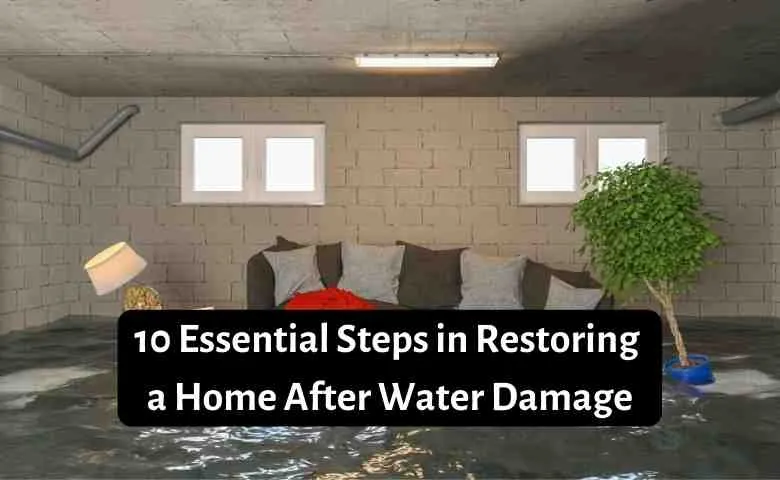Last Updated on May 8, 2025 by Admin
Residential water damage may result in devastating losses both financially and personally. Water wreaks havoc on walls, floors, foundations, and furniture and may lead to mold and serious health complications.
ConstructionCareerHub App is LIVE — built ONLY for construction careers. Don’t apply with a weak resume.
Get ATS-ready Resume Lab + Interview Copilot + Campus Placement Prep (resume screening, skill gaps, interview readiness) — in minutes & Other advanced features.
Explore Smarter Construction Career Tools →Quick check. Big impact. Start now.
Thankfully, homeowners can follow these 10 steps to reduce the effects of water damage and prepare for home restoration in a timely and cost-effective manner.
1. Notify Insurance
Water damage accounts for 29% of homeowners insurance claims, with the average settlement reaching $11,098.
Homeowners in wetter regions should consider a homeowners insurance policy to protect themselves and their property from large-scale destruction. For example, New Orleans reached its annual 63-inch average rainfall in only seven months in 2021.
An adjuster will assess the damage and provide an estimate based on their findings.
2. Document Damage
Photos and videos of the damage are critical evidence when filing an insurance claim. Pictures are also helpful for tracking rot, mold, weathering or other changes in different parts of the house.
A restoration expert can review the photos before beginning the repair process and give an accurate assessment and cost estimate for the restoration required.
3. Pursue With Caution
When documenting the water damage following a flood, it’s most important to pursue with caution while wearing protective gear.
Live wires and contamination make treading through water risky, so homeowners should stop short of heading into a basement where water has been in contact with outlets and cords.
On the home’s exterior, debris from fallen trees, damaged roofs and other materials could be dangerous if stepped on or present a higher risk of falls and injuries.
4. Shut off Electricity and the Water Supply
Homeowners must shut off the electricity and gas and close off the water supply if it’s safe.
Water and electricity don’t mix; leaving the power on could increase the chances of overheating outlets, starting a fire or sparking circuits within the walls.
Contact a professional for assistance if it’s apparent that a fuse box contains water or is overheating. Once the electricity is off, homeowners can unplug and remove damaged appliances and portable devices.
5. Remove Belongings
Separate broken and salvageable items, inspecting each for mold, cracks and shatters. Protect undamaged items by bringing them to a safe, dry location until the home is repaired.
Meanwhile, dispose of damaged furniture and household items properly and remember to recycle wherever possible.
6. Contact a Professional
Hiring a professional restoration company to assess the water damage and make repairs ensures the work is done correctly.
A leaky roof, for example, may result in moisture conducive to toxic mold growth, while a burst drainage pipe might cause damage to walls and floors in the bathroom.
Significant water damage is often too physically taxing and complex for homeowners to take on themselves, necessitating special equipment and technology only an experienced restoration contractor can provide.
Make sure the water damage restoration company you hire is fully licensed and insured, demonstrating they adhere to industry standards and regulations. Look for a company with extensive experience, quick response times, and positive customer reviews, indicating their proven track record in effectively handling a variety of water damage situations.” – Ross Kesterson, Founder of Restore Pros
7. Inspect Structural Damage
The foundation and load-bearing walls are vulnerable to water damage and may crumble or fall once dry.
Homeowners should stand 50 to 100 feet away from the damage on every side of their home and check for a sagging roof, bent and wavy walls, saturated wood and whether the house leans or tilts.
A highly-trained structural engineer can comprehensively assess weak structural defects following water damage, such as unsupported walls and floors.
Related Posts:
- 10 Renovations That Add Most Value to a Home
- How to protect your roof from water damage?
- How to handle water scarcity during the summer season in complex apartments?
- What You Should Know About Septic Tanks?
8. Drain Standing Water
Standing water causes more damage if it lingers for very long. Drain the water from the house and surrounding property to prevent mold growth and health impairments.
Depending on how much water is present, homeowners may remove the water with buckets. However, extensive damage could require a professional wet and dry vacuum that pulls the fluids out and pumps air to dry the space.
Restoration can’t begin before water and moisture removal is complete.
9. Ventilate the Home
Moisture can return if the home isn’t sufficiently dried out. Opening windows and doors for a cross breeze and setting up dehumidifiers and electric fans can expedite ventilation.
Running the air conditioner around the clock to remove as much moisture as possible is recommended if it’s safe to turn the electricity back on.
Likewise, some homes contain an attic fan that can suck out the humidity throughout the house.
10. Begin Restoration
Once an adjuster assesses the water damage and mold hazards, insurance will provide the policy’s restoration coverage, and the amount homeowners need to pay out of pocket.
As restoration begins, homeowners might consider ways to update their home technology. One potential green investment is a smart thermostat to control the home’s heating and cooling more efficiently and prevent energy waste.
Essential Steps for Restoration Success
Potential water damage is not always evident, and homeowners are usually taken off guard by the event. While the impact is undoubtedly stressful and costly, these essential steps can prepare homeowners for a successful restoration without additional effects.
Author bio:
Jane is an environmental writer who covers topics in sustainable construction and green building materials and is the editor-in-chief of Environment.co.


